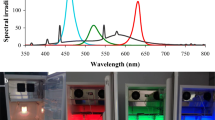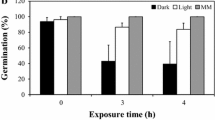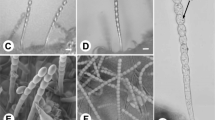Abstract
White light during mycelial growth influences high conidial stress tolerance of the insect-pathogenic fungus Metarhizium robertsii, but little is known if low- or high-white light irradiances induce different stress tolerances. The fungus was grown either in the dark using two culture media: on minimal medium (Czapek medium without sucrose = MM) or on potato dextrose agar (PDA) or PDA medium under five different continuous white light irradiances. The stress tolerances of conidia produced on all treatments were evaluated by conidial germination on PDA supplemented with KCl for osmotic stress or on PDA supplemented with menadione for oxidative stress. Conidia produced on MM in the dark were more tolerant to osmotic and oxidative stress than conidia produced on PDA in the dark or under the light. For osmotic stress, growth under the lower to higher irradiances produced conidia with similar tolerances but more tolerant than conidia produced in the dark. For oxidative stress, conidia produced under the white light irradiances were generally more tolerant to menadione than conidia produced in the dark. Moreover, conidia produced in the dark germinated at the same speed when incubated in the dark or under lower irradiance treatment. However, at higher irradiance, conidial germination was delayed compared to germination in the dark, which germinated faster. Therefore, growth under light from low to high irradiances induces similar conidial higher stress tolerances; however, higher white light irradiances cause a delay in germination speed.




Similar content being viewed by others
Availability of data and material
All datasets are available.
References
Alder-Rangel A, Bailão AM, da Cunha AF, Soares CMA, Wang C, Bonatto D, Dadachova E, Hakalehto E, Eleutherio ECA, Fernandes EKK, Braus GH, Braga GUL, Goldman GH, Malavazi I, Hallsworth JE, Takemoto JY, Fuller K, Selbmann L, Corrochano LM, Bertolini MC, Schmoll M, Pedrini N, Loera O, Finlay RD, Peralta RM, Rangel DEN (2018) The Second International Symposium on Fungal Stress: ISFUS. Fungal Biol 122:386–399. https://doi.org/10.1016/j.funbio.2017.10.011
Alder-Rangel A, Idnurm A, Brand AC, Brown AJP, Gorbushina A, Kelliher CM, Campos CB, Levin DE, Bell-Pedersen D, Dadachova E, Bauer FF, Gadd GM, Braus GH, Braga GUL, Brancini GTP, Walker GM, Druzhinina I, Pócsi I, Dijksterhuis J, Aguirre J, Hallsworth JE, Schumacher J, Wong KH, Selbmann L, Corrochano LM, Kupiec M, Momany M, Molin M, Requena N, Yarden O, Cordero RJB, Fischer R, Pascon RC, Mancinelli RL, Emri T, Basso TO, Rangel DEN (2020) The Third International Symposium on Fungal Stress – ISFUS. Fungal Biol 124:235–252. https://doi.org/10.1016/j.funbio.2020.02.007
Alston DG, Rangel DEN, Lacey LA, Golez HG, Kim JJ, Roberts DW (2005) Evaluation of novel fungal and nematode isolates for control of Conotrachelus nenuphar (Coleoptera: Curculionidae) larvae. Biol Control 35:163–171. https://doi.org/10.1016/j.biocontrol.2005.06.011
Araújo CAS, Ferreira PC, Pupin B, Dias LP, Avalos J, Edwards J, Hallsworth JE, Rangel DEN (2020) Osmotolerance as a determinant of microbial ecology: a study of phylogenetically diverse fungi. Fungal Biol 124:273–288. https://doi.org/10.1016/j.funbio.2019.09.001
Aver’yanov AA, Lapikova VP, Pasechnik TD, Abramova OS, Gaivoronskaya LM, Kuznetsov VV, Baker CJ (2014) Pre-illumination of rice blast conidia induces tolerance to subsequent oxidative stress. Fungal Biol 118:743–753. https://doi.org/10.1016/j.funbio.2014.06.003
Azevedo RFF, Souza RKF, Braga GUL, Rangel DEN (2014) Responsiveness of entomopathogenic fungi to menadione-induced oxidative stress. Fungal Biol 118:990–995. https://doi.org/10.1016/j.funbio.2014.09.003
Bergman K, Burke PV, Cerdaolm E, David CN, Delbruck M, Foster KW, Goodell EW, Heisenbe M, Meissner G, Zalokar M, Dennison DS, Shropshi W (1969) Phycomyces. Bacteriol Rev 33:99–157
Braga GUL, Rangel DEN, Flint SD, Miller CD, Anderson AJ, Roberts DW (2002) Damage and recovery from UV-B exposure in conidia of the entomopathogens Verticillium lecanii and Aphanocladium album. Mycologia 94:912–920. http://www.jstor.org/stable/3761859
Brancini GTP, Rangel DEN, Braga GÚL (2016) Exposure of Metarhizium acridum mycelium to light induces tolerance to UV-B radiation. FEMS Microbiol Lett. https://doi.org/10.1093/femsle/fnw036
Brancini GTP, Ferreira MES, Rangel DEN, Braga GÚL (2019) Combining transcriptomics and proteomics reveals potential post-transcriptional control of gene expression after light exposure in Metarhizium acridum. G Genes Genomes Genet 9:2951–2961. https://doi.org/10.1534/g3.119.400430
Corrochano LM, Cerda-Olmedo E (1988) Photomorphogenesis in Phycomyces: Dependence on environmental conditions. Planta 174:309–314. https://doi.org/10.1007/bf00959515
Corrochano LM, Cerdá-Olmedo E (1990) Photomorphogenesis in Phycomyces: Competence period and stimulus-response relationships. J Photochem Photobiol B Biol 5:255–266. https://doi.org/10.1016/1011-1344(90)80010-U
Costa TPC, Rodrigues EM, Dias LP, Pupin B, Ferreira PC, Rangel DEN (2021) Different wavelengths of visible light influence the conidial production and tolerance to ultra-violet radiation of the plant pathogens Colletotrichum acutatum and Fusarium fujikuroi. Eur J Plant Pathol 159:105–115. https://doi.org/10.1007/s10658-020-02146-y
Dasgupta A, Chen C-H, Lee C, Gladfelter AS, Dunlap JC, Loros JJ (2015) Biological significance of photoreceptor photocycle length: VIVID photocycle governs the dynamic VIVID-White Collar Complex pool mediating photo-adaptation and response to changes in light intensity Plos. Genetics 11:e1005215. https://doi.org/10.1371/journal.pgen.1005215
Dias LP, Araújo CAS, Pupin B, Ferreira PC, Braga GÚL, Rangel DEN (2018) The Xenon test chamber Q-SUN® for testing realistic tolerances of fungi exposed to simulated full spectrum solar radiation. Fungal Biol 122:592–601. https://doi.org/10.1016/j.funbio.2018.01.003
Dias LP, Pedrini N, Braga GUL, Ferreira PC, Pupin B, Araújo CAS, Corrochano LM, Rangel DEN (2020) Outcome of blue, green, red, and white light on Metarhizium robertsii during mycelial growth on conidial stress tolerance and gene expression. Fungal Biol 124:263–272. https://doi.org/10.1016/j.funbio.2019.04.007
Dias LP, Souza RKF, Pupin B, Rangel DEN (2021) Conidiation under illumination enhances conidial tolerance of insect-pathogenic fungi to environmental stresses. Fungal Biol 125:891–904. https://doi.org/10.1016/j.funbio.2021.06.003
Dunlap JC, Loros JJ (2017) Making time: conservation of biological clocks from fungi to animals. Microbiol Spectr 5:101128. https://doi.org/10.1128/microbiolspec.FUNK-0039-2016
Ferreira DF (2011) Sisvar: a computer statistical analysis system. Ciência e Agrotecnologia 35:1039–1042
Ferreira DF (1999) SISVAR 4.3. Sistema de análises estatísticas, CD-ROM edn. Universidade Federal de Lavras, UFLA, Lavras, MG, Brazil
Fuller KK, Ringelberg CS, Loros JJ, Dunlap JC (2013) The fungal pathogen Aspergillus fumigatus regulates growth, metabolism, and stress resistance in response to light. Mbio. https://doi.org/10.1128/mBio.00142-13
Fuller KK, Dunlap JC, Loros JJ (2016) Fungal light sensing at the bench and beyond. In: Friedmann T, Dunlap JC, Goodwin SF (eds) Advances in genetics, vol 96. pp 1–51. doi:https://doi.org/10.1016/bs.adgen.2016.08.002
Griffin DH (1996) Fungal physiology, 2nd edn. Wiley, New York
Humber RA (2014) USDA-ARS collection of entomopathogenic fungal cultures—catalog of strains. USDA-ARS Biological Integrated Pest Management Research, Robert W. Holley Center for Agriculture and Health, Ithaca
Idnurm A, Crosson S (2009) The photobiology of microbial pathogenesis. Plos Pathog 5:e1000470. https://doi.org/10.1371/journal.ppat.1000470
Idnurm A, Heitman J (2005) Light controls growth and development via a conserved pathway in the fungal Kingdom. Plos Biol 3:615–626. https://doi.org/10.1371/journal.pbio.0030095
Lee K, Singh P, Chung W-C, Ash J, Kim TS, Hang L, Park S (2006) Light regulation of asexual development in the rice blast fungus Magnaporthe Oryzae. Fungal Genet Biol 43:694–706
Li ZZ, Alves SB, Roberts DW, Fan MZ, Delalibera I, Tang J, Lopes RB, Faria M, Rangel DEN (2010) Biological control of insects in Brazil and China: history, current programs and reasons for their successes using entomopathogenic fungi. Biocontrol Sci Technol 20:117–136. https://doi.org/10.1080/09583150903431665
Medina EQA, Oliveira AS, Medina HR, Rangel DEN (2020) Serendipity in the Wrestle between Trichoderma and Metarhizium. Fungal Biol. https://doi.org/10.1016/j.funbio.2020.01.002
Oliveira AS, Braga GUL, Rangel DEN (2018) Metarhizium Robertsii illuminated during mycelial growth produces conidia with increased germination speed and virulence. Fungal Biol 122:555–562. https://doi.org/10.1016/j.funbio.2017.12.009
Rangel DEN, Braga GUL, Anderson AJ, Roberts DW (2005) Variability in conidial thermotolerance of Metarhizium anisopliae isolates from different geographic origins. J Invertebr Pathol 88:116–125. https://doi.org/10.1016/j.jip.2004.11.007
Rangel DEN, Anderson AJ, Roberts DW (2006) Growth of Metarhizium anisopliae on non-preferred carbon sources yields conidia with increased UV-B tolerance. J Invertebr Pathol 93:127–134. https://doi.org/10.1016/j.jip.2006.05.011
Rangel DEN, Alston DG, Roberts DW (2008a) Effects of physical and nutritional stress conditions during mycelial growth on conidial germination speed, adhesion to host cuticle, and virulence of Metarhizium anisopliae, an entomopathogenic fungus. Mycol Res 112:1355–1361
Rangel DEN, Anderson AJ, Roberts DW (2008b) Evaluating physical and nutritional stress during mycelial growth as inducers of tolerance to heat and UV-B radiation in Metarhizium anisopliae conidia. Mycol Res 112:1362–1372. https://doi.org/10.1016/j.mycres.2008.04.013
Rangel DEN, Fernandes EKK, Braga GUL, Roberts DW (2011) Visible light during mycelial growth and conidiation of Metarhizium robertsii produces conidia with increased stress tolerance. FEMS Microbiol Lett 315:81–86. https://doi.org/10.1111/j.1574-6968.2010.02168.x
Rangel DEN, Fernandes EKK, Anderson AJ, Roberts DW (2012) Culture of Metarhizium Robertsii on salicylic-acid supplemented medium induces increased conidial thermotolerance. Fungal Biol 116:438–442
Rangel DEN, Braga GUL, Fernandes ÉKK, Keyser CA, Hallsworth JE, Roberts DW (2015) Stress tolerance and virulence of insect-pathogenic fungi are determined by environmental conditions during conidial formation. Curr Gen 61:383–404. https://doi.org/10.1007/s00294-015-0477-y
Rangel DEN, Piedrabuena AE, Roitman I, Messias CL (2020) Laboratory and field studies for the control of Chagas disease vectors using the fungus Metarhizium anisopliae. Arch Insect Biochem Physiol 105:e21745. https://doi.org/10.1002/arch.21745
Rangel DEN, Bignayan HG, Golez HG, Keyser CA, Evans EW, Roberts DW (2021) Virulence of the insect-pathogenic fungi Metarhizium spp. to Mormon crickets, Anabrus simplex (Orthoptera: Tettigoniidae). Bull Entomol Res. https://doi.org/10.1017/s0007485321000663
Röhrig J, Kastner C, Fischer R (2013) Light inhibits spore germination through phytochrome in Aspergillus Nidulans. Curr Gen 59:55–62. https://doi.org/10.1007/s00294-013-0387-9
Sanchez-Murillo RI, de la Torre-Martinez M, Aguirre-Linares J, Herrera-Estrella A (2004) Light-regulated asexual reproduction in Paecilomyces Fumosoroseus. Microbiology 150:311–319
Sanz C, Rodriguez-Romero J, Idnurm A, Christie JM, Heitman J, Corrochano LM, Eslava AP (2009) Phycomyces MADB interacts with MADA to form the primary photoreceptor complex for fungal phototropism. Proc Natl Acad Sci U S A 106:7095–7100
Schmoll M, Franchi L, Kubicek CP (2005) Envoy, a PAS/LOV domain protein of Hypocrea jecorina (anamorph Trichoderma reesei), modulates cellulase gene transcription in response to light. Eukaryot Cell 4:1998–2007
Souza RKF, Azevedo RFF, Lobo AO, Rangel DEN (2014) Conidial water affinity is an important characteristic for thermotolerance in entomopathogenic fungi. Biocontrol Sci Technol 24:448–461. https://doi.org/10.1080/09583157.2013.871223
Tansey MR, Jack MA (1975) Moonlight, mushrooms and moulds. J Theor Biol 51:403–407. https://doi.org/10.1016/0022-5193(75)90069-7
Tisch D, Schmoll M (2010) Light regulation of metabolic pathways in fungi. Appl Microbiol Biotechnol 85:1259–1277. https://doi.org/10.1007/s00253-009-2320-1
Verma S, Idnurm A (2013) The Uve1 endonuclease is regulated by the white collar complex to protect Cryptococcus neoformans from UV damage. Plos Genet. https://doi.org/10.1371/journal.pgen.1003769
Yafetto L, Carroll L, Cui Y, Davis DJ, Fischer MW, Henterly AC, Kessler JD, Kilroy HA, Shidler JB, Stolze-Rybczynski JL, Sugawara Z, Money NP (2008) The fastest flights in nature: high-speed spore discharge mechanisms among fungi. PLoS ONE 3:e3237. https://doi.org/10.1371/journal.pone.0003237
Zhang Y-J, Li Z-H, Luo Z-B, Zhang J-Q, Fan Y-H, Pei Y (2009) Light stimulates conidiation of the entomopathogenic fungus Beauveria Bassiana. Biocontrol Sci Technol 19:91–101. https://doi.org/10.1080/09583150802588516
Acknowledgements
We are grateful to Richard A. Humber (USDA-ARS Collection of Entomopathogenic Fungal Cultures, R.W. Holley Center for Agriculture & Health, Ithaca, NY) for the donation of the fungal isolate. The authors also thank Alexander Idnurm (University of Melbourne, Melbourne, Australia) and Alene Alder-Rangel (Alder’s English Services) for their valuable review on the manuscript. This research was supported by grants from the National Council for Scientific and Technological Development (CNPq) of Brazil PQ1D 302100/2018-0 and the São Paulo Research Foundation (FAPESP) 2010/06374-1 and 2013/50518-6 for D.E.N.R. and for the PhD fellowship for L.P.D 2013/25964-2. We also thank the Coordination for the Improvement of Higher Level Personnel (CAPES) of Brazil for a post-doctoral fellowship for B.P.
Funding
This research was supported by terminated grants from the National Council for Scientific and Technological Development (CNPq) of Brazil and São Paulo Research Foundation (FAPESP).
Author information
Authors and Affiliations
Contributions
Conceived and designed the experiments: DENR. Performed the experiments: LPD, DENR, and BP. Prepared all figures: DENR. Analyzed the data: BP and DENR. Wrote the paper: DENR.
Corresponding author
Ethics declarations
Ethics approval
No ethical permissions were required for this work which involved no experimentation involving animals or human samples.
Consent to participate
This article used no human subjects.
Competing interests
The authors declare no conflict of interest.
Consent for publication
All authors read and approved the final version of the manuscript.
Additional information
Communicated by Erko Stackebrandt.
Publisher's Note
Springer Nature remains neutral with regard to jurisdictional claims in published maps and institutional affiliations.
Deceased: Donald W. Roberts.
Rights and permissions
About this article
Cite this article
Dias, L.P., Pupin, B., Roberts, D.W. et al. Low- or high-white light irradiance induces similar conidial stress tolerance in Metarhizium robertsii. Arch Microbiol 204, 83 (2022). https://doi.org/10.1007/s00203-021-02730-8
Received:
Revised:
Accepted:
Published:
DOI: https://doi.org/10.1007/s00203-021-02730-8




